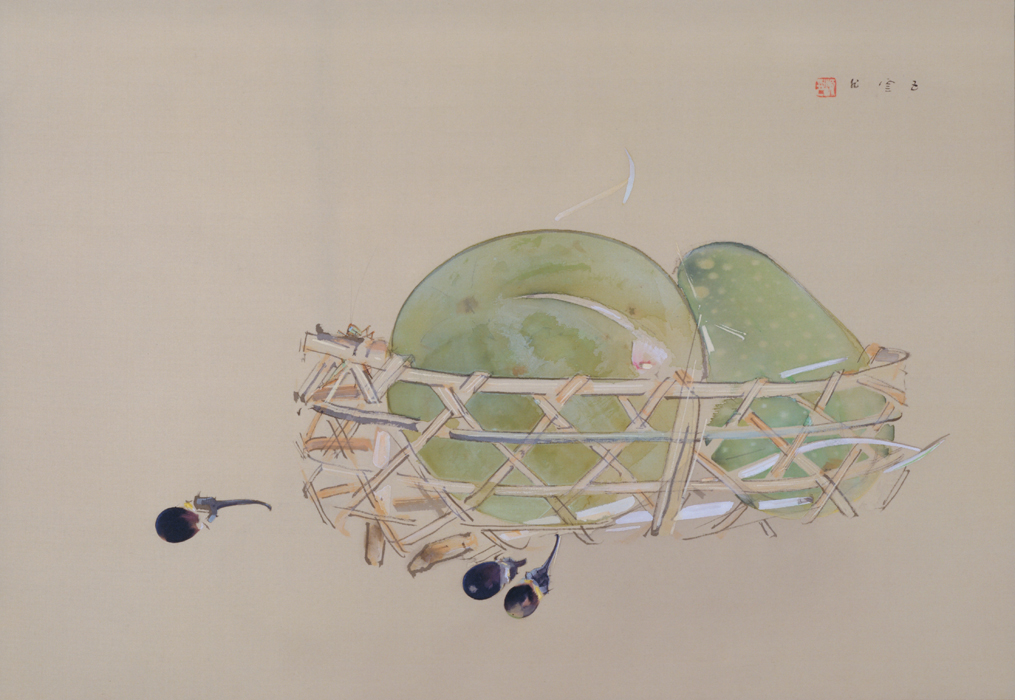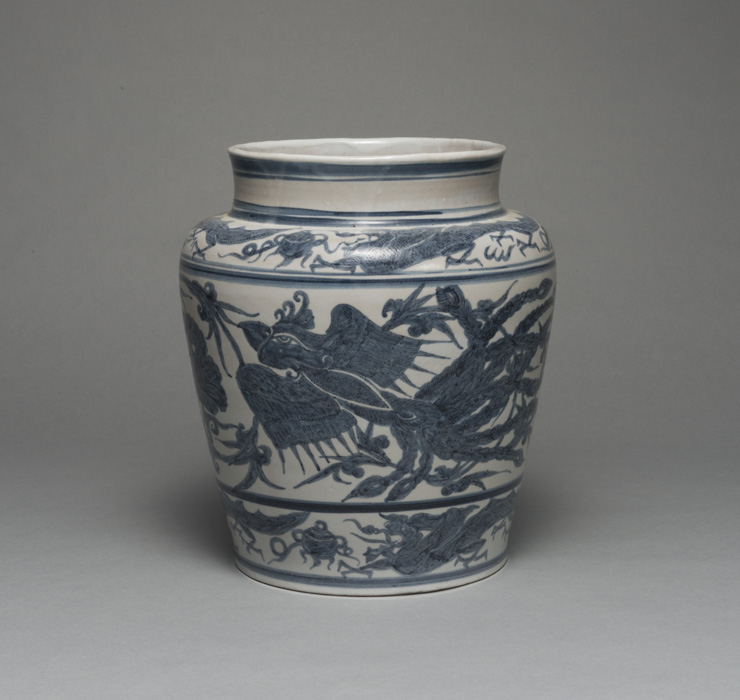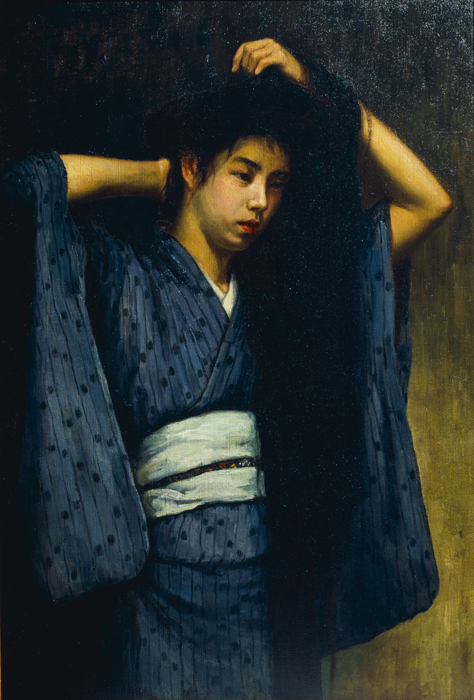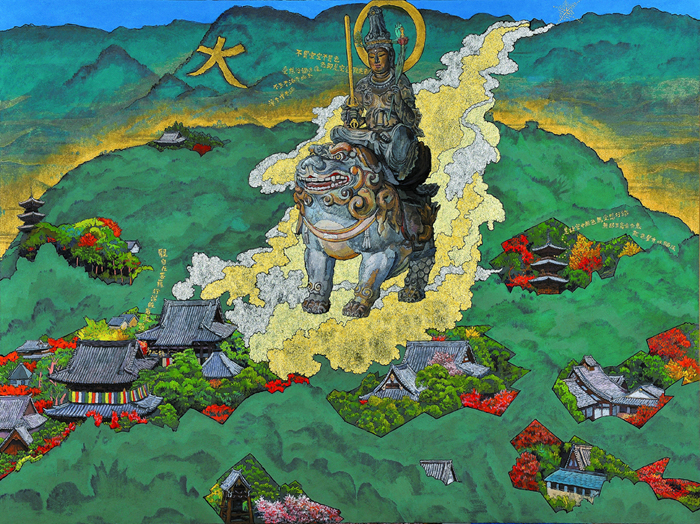
Collection Gallery
4th Collection Gallery Exhibition 2019–2020
2019.08.08 thu. - 10.27 sun.
The Beauty of Traditional Japanese Clothing KIKUCHI Keigetsu, Fresh Breeze in the Morning, 1937, [on View: Aug. 8–Sept. 8] KIKUCHI Keigetsu, Matsukaze (A Scene from the Noh Play), 1940 [on View: Sept. 10–Oct. 27]
The International Council of Museums conference ICOM 2019 will be held in Kyoto from September 1–7. As part of this event, the Museum of Modern Art, Kyoto will provide a venue for the ICOM Costume Committee. Also, in the Exhibition Hall on the third floor (and part of the Collection Gallery in the fourth floor) we will present the exhibition Dress Code: Are You Playing Fashion? jointly with the Kyoto Costume Institute (KCI) (August 9 - October 14). The ICOM 2019 theme is "Museums as Cultural Hubs: The Future of Tradition." In conjunction with this, in this section we present an exhibit focused on works by modern-day Japanese painters active in Kyoto depicting the beauty of traditional Japanese costumes.
Most of the painters featured here lived in a society where Western-style clothing had already become commonplace. However, in Kyoto there were many occupations where it was appropriate to wear traditional dress, as well as occupations related to the traditional apparel industry, so compared to other cities there were still a relatively large number of people living and working in traditional Japanese dress. For example, there were the maiko and geiko of the Gokagai (five geisha districts) and courtesans of Shimabara. Their traditional attire has been a subject of fascination and has often been rendered not only in Kyoto, but also by many other artists from East and West alike. Painters from the modern era onward did not have to rely only on imagination, even when depicting historical characters, as they had many references in the antique textile fragments and old garments (kimono and other traditional costumes, Buddhist priests' stoles) preserved in Kyoto, and in addition to copying traditional patterns, designs, and shapes, they pursued realism by representing, directly from life, people who wore Japanese clothing in their everyday lives, the draped fabric describing straight lines that differed completely from those of Western clothing. Some artists focused on the interesting forms that apparel provided. Because the patterns and designs of Japanese dress embodied the seasons, much could be expressed about the scene and even the emotions of the wearer without even painting the background, making it ideal for the concise renderings of Nihonga (modern Japanese-style painting). As you enjoy these portrayals of people wearing various forms of traditional Japanese clothing, please stop and see what you can interpret about the scenes and situations.
Summer Scenery in Japanese-style Painting (First Term) / Autumn Scenery in Japanese-style Painting (Second Term) NISHIMURA Goun, Fresh Vegetables, c. 1935 [on View: Aug. 8–Sept. 8] KUBOTA Beisen, Ivy Turning into Yellow and Red, 1885 [on View: Sept. 10–Oct. 27]
Japan has a four-season climate, and since ancient times the Japanese have celebrated the beauty of each season in poetry, prose, and painting. In this section featuring Nihonga (modern Japanese-style painting) from the museum's collection, we present works depicting classic summer and autumn scenes, divided into two phases, summer (First Term: August 8 - September 8) and autumn (Second Term: September 10 - October 27).
Nothing is more evocative of summer than a water-related scene. A white heron bathing in a lotus pond early on a summer morning, or goldfish swimming in a bowl, are cool on the viewer's eyes. Families come to beat the heat in fountains in parks, and people in yukata (casual summer kimono) savor the evening cool by the riverside. Houses are outfitted for the season, with bamboo blinds hung and fans displayed. Eating vegetables such as wax gourds and tomatoes helps overcome summer fatigue. Don't you feel a bit cooled just looking at them? Meanwhile, while adults are trying to get some respite from the heat, children are busily running around catching cicadas and frogs. Think back to a summer vacation day long ago, and enjoy these paintings at your leisure.
Fall foliage is the most iconic symbol of autumn. In Kyoto the trees do not change colors until November, but even in September, there is something in the air that makes us anticipate the autumn leaves. Please enjoy these depictions of autumn leaves by some of Kyoto's greatest modern Nihonga painters. Autumn is also the harvest season, and a time of festivals with prayers and rites for an abundant harvest. Tomita Keisen drew a picture of the Ox Festival at Koryu-ji, Uzumasa (originally the Osake Shrine festival held on the shrine grounds). This festival, the Kurama Fire Festival, and the Imamiya Shrine Yasurai Matsuri Festival are known as Kyoto's three major odd festivals. However, in recent years the ox festival has not been held because it is difficult to procure the animals, so we hope you enjoy a taste of this intriguing and comical tradition through this painting which the museum just acquired last year.
Shozoku: Dress Code in Japan KAMISAKA, Sekka / SAKAMAKI (TSUKIOKA), Kogyo, Twelve Months of Noh Pictures, 1921 March: Dōjō-ji from Twelve Months of Noh Pictures
What is the nature of "dress codes" in Japan? One example we can cite is the Ifukurei ("rules of clothing"), which was enacted in 701 during the Nara Period (710–794) and became the prototype of Heian Period (794–1192) shozoku (codified attire) and Noh costumes. These rules were established under the Taiho Ritsuryo Code, and clothing categorized as raifuku (ceremonial clothing), chofuku (court attire), and seifuku (uniforms) also showed the rank of the wearer. To wear this attire was to wear codified symbols, and it did not necessarily reflect personal tastes. The Jidai Gyoretsu historical pageant held every October at Heian-jingu Shrine features costumes that represent their respective era. Each costume, precisely regulated so as to show the wearer's identity, also helped form our stereotypical image of its era.
The special exhibition Dress Code: Are You Playing Fashion?, currently on view, deals with various aspects of how we see and are seen in the context of fashion. In line with this theme, this section presents works from the museum's collection relating to shozoku "dress codes" in Japan. A centerpiece is Twelve Months of Noh Pictures by Kamisaka Sekka and Tsukioka Kogyo, a master of Noh Pictures. Ujiyama Teppei's Inspired by the Noh Play "Nue" represents a scene from a Noh play in abstract form. Also, we are pleased to present Tomatsu Shomei's Kyoto-Mandala, a series of photographs capturing Kyoto rituals and providing fascinating glimpses of the human faces behind the codified attire.
From our contemporary art collection, the exhibit includes Work 64-14 & 15: A Court Dance and Music by Isobe Yukihisa. It features a reproduction of Tawaraya Sotatsu's Bugaku Dancers: Pair of two-panel screens (Daigo-ji Temple) on its surface, and when the panels are opened, several badge-like motifs appear. The disparity of this imagery with our classical image of traditional costume makes a powerful impression. This section covers a wide range of genres, from photography to Nihonga (modern Japanese-style painting) to contemporary art, while exploring how artists address images of traditional dress and connect them to their work.
Dress of Japan TABATA, Kihachi III, Long-sleeved Kimono, Chrysanthemum Motif, late Taisho period [on View: Aug. 8–Sept. 8] TABATA, Kihachi III Long-sleeved kimono, Phoenix and Paulownia Motif, 1954 [on View: Sept. 10–Oct. 27]
When we say "dress," we mean not merely clothing, but the wearer's overall presentation of an orderly and beautiful image. Throughout history the Japanese have produced various forms of dress that vary according to the season and the occasion. The best known of these is the kimono. The kimono was once an everyday garment, but now it occupies a special position in Japanese life and enlivens auspicious occasions. The classic kimono fabric is tsumugi (silk pongee), which was used for everyday around-the-house wear and developed throughout Japan. It has a soft texture, achieved by pre-dyeing the thread before weaving, and today is also favored for more going out on the town. Meanwhile, semi-formal "visiting wear" such as piece-dyed Yuzen-printed kimono and furisode (long-sleeved kimono) worn on formal or ceremonial occasions differ in texture and quality from tsumugi, which was originally for casual everyday wear. In addition to the visual and tactile characteristics of design and texture, during the Heian Period (794–1185) there developed the custom of perfuming kimono by burning incense with seasonal scents, which is still carried on today.
There is something about people's dress that can enchant us. Dressing is a cultural act performed in the context of a two-way relationship between the wearer and the onlooker, and in order for a particular outfit to appear beautiful for us, we need to be attuned to the specific qualities of the wearer. The Japanese largely changed their lifestyles as they increasingly adopted Western customs and articles following the Meiji Restoration of 1868, and Takehisa Yumeji, an artist active during the Taisho Era (1868–1912), was inspired to produce dreamlike, lyrical depictions of these encounters between East and West.
Selected Works of KAWAI Kanjiro KAWAI Kanjiro, Blue Underglazed Jar of Flying Phoenix under the Flowers Design 1922
Kawai Kanjiro, one of modern Japan's most renowned ceramic artists, was born in 1890 in what is now Yasugi, Shimane Prefecture. After graduating from the Tokyo Higher Technical School (present-day Tokyo Institute of Technology), he worked as a technician at the Kyoto Research Institute for Ceramics, where he dedicated himself to the study of numerous glazes such as celadon and cinnabar. After leaving the institute in 1917, he obtained his own noborigama climbing kiln, called Shokeiyo, in 1920. His first solo exhibition was held in 1921, and he earned high acclaim for works in a style inspired by Chinese and Korean ceramics. At this time Kawai was hailed as "the arrival of a comet" and "worthy of being a National Treasure," but he did not rest on his laurels and subsequently changed creative direction significantly, producing ceramics that reflected the inextricable bond between art and everyday life as the Mingei (Folk Art) movement progressed. In his later years, Kawai's works became ever more formally ambitious, brimming with the joy of life itself.
The core of the museum's Kawai Kanjiro holdings is the Kawakatsu Collection assembled by Kawakatsu Kenichi, a longtime supporter of the artist. The Kawakatsu Collection is the most complete collection of Kawai's work in terms of both quality and quantity, including the work that won a Grand Prix at the 1937 Paris World Exposition. It is also widely recognized as a valuable reference for tracing the evolution of Kawai's creative mentality, including representative examples of his work from every stage of his career. In addition to the Kawakatsu Collection, other works by Kawai have been gifted to the museum. Here, we are pleased to present the world of Kawai Kanjiro through the Kawakatsu Collection and pieces that collectors have kindly donated.
Dressed / Undressed SAWABE Seigoro, Combing, 1909
Since ancient times, both men and women have adorned themselves with clothing and accessories. Attire expresses or represents people's role and status, way of life, and personal taste or aesthetic sensibilities. Depictions of attire in painted or sculptural portraits of famous people give us an idea of those people's personae and principles.
But what of works representing the nude, the unclothed or undressed body? In Western art, depending on the body's context, even a nude figure can be "clothed" in narrative, as in depictions of mythological figures such as Venus and Apollo. Being unclothed, or taking off clothes, can also be a form of guise in Western art, and nudity can be said to follow its own set of "dress codes."
In Japanese art, since ancient times there have been rules governing representations of clothed figures, but as for nudes, codes were not established even in the Meiji Era (1868–1912) when Western art traditions came to be adopted. A naked figure was simply not wearing any clothing, and Japanese artists followed Western art practices and learned by imitation without truly grasping the significance or beauty of the nude. During a debate over the merits of the nude in art in 1891, the Western-style painter Asai Chu was skeptical, saying "There is no shortage of other things we can paint," probably because of his level-headed recognition that depictions of the nude had not been adequately codified in Japan.
So, how did modern Japanese artists depict various states of "dress?" Please enjoy these works from the museum's collection of Western-style art.
Commemoration of the ICOM: Kinutani Koji KINUTANI Koji, Monju Bosatsu (Manjusri) Descends to Kurodani Konkai-Komyo-ji Temple Ⅰ, 2017
The International Council of Museums (ICOM) will hold its 2019 general conference in Kyoto from Sunday, September 1 to Saturday, September 7. ICOM's is the world's largest, and indeed only international non-governmental organization dedicated to the advancement and development of museums. It was founded in 1946, and as of 2016 it has 37,000 members working in the museum field, from 141 countries and regions around the world. ICOM has various large and small committees, but it is only every three years that all these committees meet at a general conference is held, and this time Kyoto is the host city. It is the first time the conference has been held in Japan.
The original poster for this conference was created by Kinutani Koji. After studying mural painting at the graduate school of Tokyo University of the Arts, Kinutani went abroad to enroll in the Academy of Fine Arts of Venice and study the ancient techniques of Italian fresco with master Bruno Saetti. He returned to Japan in 1973. Portrait of Mr. Anselmo (collection of the National Museum of Modern Art, Tokyo), produced while he was studying abroad, was nominated for the 17th Yasui Prize (1974), and won this prize recognized as emerging artists' gateway to a full-fledged career. He remains prolifically productive to this day, and is also enthusiastically engaged with education of younger generations, including active involvement with the Kids Dream / Art / Academy, operated by the Agency for Cultural Affairs and the Japan Art Academy in order to convey the joys of cultural and artistic activities to children.
Kinutani's enormous, vividly colored paintings contain a vast variety of motifs drawn from his boundless imagination. Kinutani grew up in Nara and played on the grounds of historic Kofuku-ji Temple as a child, and his art is imbued with profound spirituality underpinned by deep knowledge of and familiarity with Buddhist thought and culture. For example, Love Buried in the Sand conveys the artist's vision of the suffering and transience of life with anguished voices crying "Aaaa…" and passages from the Heart Sutra written on the sand in bright colors. Please look carefully for the messages contained in the vibrant world of Kinutani's work.
Exhibition Period
2019.08.08 thu. - 10.27 sun.
[First term]8.8 thu.~9.8 sun.
[Second term]9.10 tue.~10.27 sun.
Themes of Exhibition
The Beauty of Traditional Japanese Clothing
Summer Scenery in Japanese-style Painting (First Term) / Autumn Scenery in Japanese-style Painting (Second Term)
Shozoku: Dress Code in Japan
Dress of Japan
Selected Works of KAWAI Kanjiro
Dressed / Undressed
Commemoration of the ICOM: Kinutani Koji
[Outside] Outdoor Sculptures
List of Works
4th Collection Gallery Exhibition 2019–2020 (First Term)(125 works)(PDF)
4th Collection Gallery Exhibition 2019–2020 (Second Term)(125 works)(PDF)
Free Audio Guide App
How to use Free Audio Guide (PDF)
List of Works
4th Collection Gallery Exhibition 2019–2020 (First Term)(125 works)(PDF)
4th Collection Gallery Exhibition 2019–2020 (Second Term)(125 works)(PDF)
Free Audio Guide App How to use Free Audio Guide (PDF)



![KIKUCHI Keigetsu, Fresh Breeze in the Morning, 1937, [on View: Aug. 8–Sept. 8]](https://www.momak.go.jp/English/wp-content/uploads/sites/2/2019/11/4th-菊池契月_朝爽_1937.jpg)
![KIKUCHI Keigetsu, Matsukaze (A Scene from the Noh Play), 1940 [on View: Sept. 10–Oct. 27]](https://www.momak.go.jp/English/wp-content/uploads/sites/2/2019/11/4th-菊池契月_松風_1935-44-2-e1577173893139.jpg)
![NISHIMURA Goun, Fresh Vegetables, c. 1935 [on View: Aug. 8–Sept. 8]](https://www.momak.go.jp/English/wp-content/uploads/sites/2/2019/11/4th-西村五雲《新瓜新菜》1935.jpg)
![KUBOTA Beisen, Ivy Turning into Yellow and Red, 1885 [on View: Sept. 10–Oct. 27]](https://www.momak.go.jp/English/wp-content/uploads/sites/2/2019/11/cc_219_04_04.jpg)
耕漁_能楽絵十二月_192101/15_-1024x857.jpg)
耕漁_能楽絵十二月_192104/15.jpg)
![TABATA, Kihachi III, Long-sleeved Kimono, Chrysanthemum Motif, late Taisho period [on View: Aug. 8–Sept. 8]](https://www.momak.go.jp/English/wp-content/uploads/sites/2/2019/11/4th-三代-田畑喜八_友禅菊華文振袖_大正末.jpg)
![TABATA, Kihachi III Long-sleeved kimono, Phoenix and Paulownia Motif, 1954 [on View: Sept. 10–Oct. 27]](https://www.momak.go.jp/English/wp-content/uploads/sites/2/2019/11/4th-三代-田畑喜八《一越縮緬地鳳凰桐文振袖》1954.jpg)


